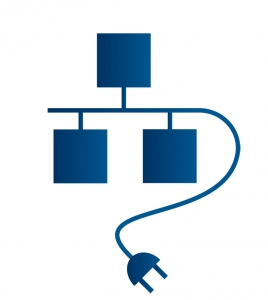Power over Ethernet (PoE).
 PoE stands for Power over Ethernet. Power over Ethernet (PoE) allows the same cable that delivers data to also deliver power to IP enabled devices rather than by power cords. Two major drivers behind the development of Power over Ethernet (PoE) were Voice over IP (VoIP) and Wireless LAN Networks (WLAN).
PoE stands for Power over Ethernet. Power over Ethernet (PoE) allows the same cable that delivers data to also deliver power to IP enabled devices rather than by power cords. Two major drivers behind the development of Power over Ethernet (PoE) were Voice over IP (VoIP) and Wireless LAN Networks (WLAN).
In the case of VoIP, the need to power desktop phones without an additional power supply drove the desire for line power where power is transmitted along with data. For Wireless LAN (WLAN) applications, Wireless Access Points (WAP) are often needed where it may be impractical or expensive to run AC power.
The ability to power IP phones, Wireless Access Points, security cameras, card scanners and other devices from switches via standard ethernet cabling decreases the costs of deploying IP technology and reduces maintenance costs.
What are the advantages of Power over Ethernet (PoE)?
Simplicity:
- Power over Ethernet (PoE) uses standard ethernet cables and only requirement is a PoE compliant switch.
- Powering devices over the network eliminates the need for separate data and power cables
- Simplify the installation and maintenance and centralised power supply
Flexibility:
- Power over Ethernet (PoE) technology allows for a scalable and flexible networking infrastructure.
- Devices can be placed of mounted where they are needed, which may or may not be near existing power sources.
Cost Savings:
- Network installation and energy management.
- Installation time, wiring costs can be potentially cut in half by requiring only one wire (or cable) to be routed to each device.
- Larger savings can be realised through effective energy management. Most enterprise class PoE switches support the simple network management protocol (SNMP), which gives network administrators the ability to remotely monitor and manage power consumption of POE powered devices.
Reliability:
- Redundant power during power outages via their network connections alone. During a power failure, a UPS continues to provide power the Power over Ethernet (PoE) compliant switch, which in turn continues to power the PoE powered devices (i.e. security cameras, VoIP telephones, Wireless Access Points, etc. )
- Easier control over the power of remotely connected devices and you can troubleshoot, restart, shutdown, or put equipment into a safe state if the need arises.
The simplicity, reliability, and cost savings make a compelling argument for combining power and data into one cable – even more so with the recent emphasis on energy conservation.
Finding the right partner to design, implement or refresh your corporate wireless solution is key to realising the full benefits of Power over Ethernet (POE).
